Abstract
The reliability of immunological identification of Neisseria gonorrhoeae using polyclonal and monoclonal antibody coagglutination reagents has been evaluated. When clinical isolates of neisseriae were tested in an "in use" trial the sensitivity and specificity of each reagent were similar and the overall agreement with carbohydrate utilisation was 97.9% (141/144) for the polyclonal antibody reagent and 97.2% (140/144) for the monoclonal reagent. When results of testing 13 stock cultures of N lactamica and five stock cultures of beta-lactamase producing Branhamella catarrhalis were combined with the results for clinical isolates of non-gonococcal neisseriae the agreement with carbohydrate utilisation was 86.5% (64/74) for the polyclonal reagent and 97.3% (72/74) for the monoclonal reagent: this difference is statistically significant at the 5% level. Calculation of positive and negative predictive values showed differences in the reliability of the coagglutination reagents when testing Gram negative diplococci isolated from various anatomical sites. The value and limitations of the polyclonal and monoclonal reagents were similar with respect to anogenital isolates: N gonorrhoeae was confirmed by a positive result but not excluded by a negative result. The monoclonal reagent was superior for testing throat isolates; although a negative result with either reagent confirmed Gram negative diplococci as non-gonococcal neisseriae, a positive result with the monoclonal reagent was more reliable (predictive value 93%) than a positive result with the polyclonal reagent (predictive value 86%).
Full text
PDF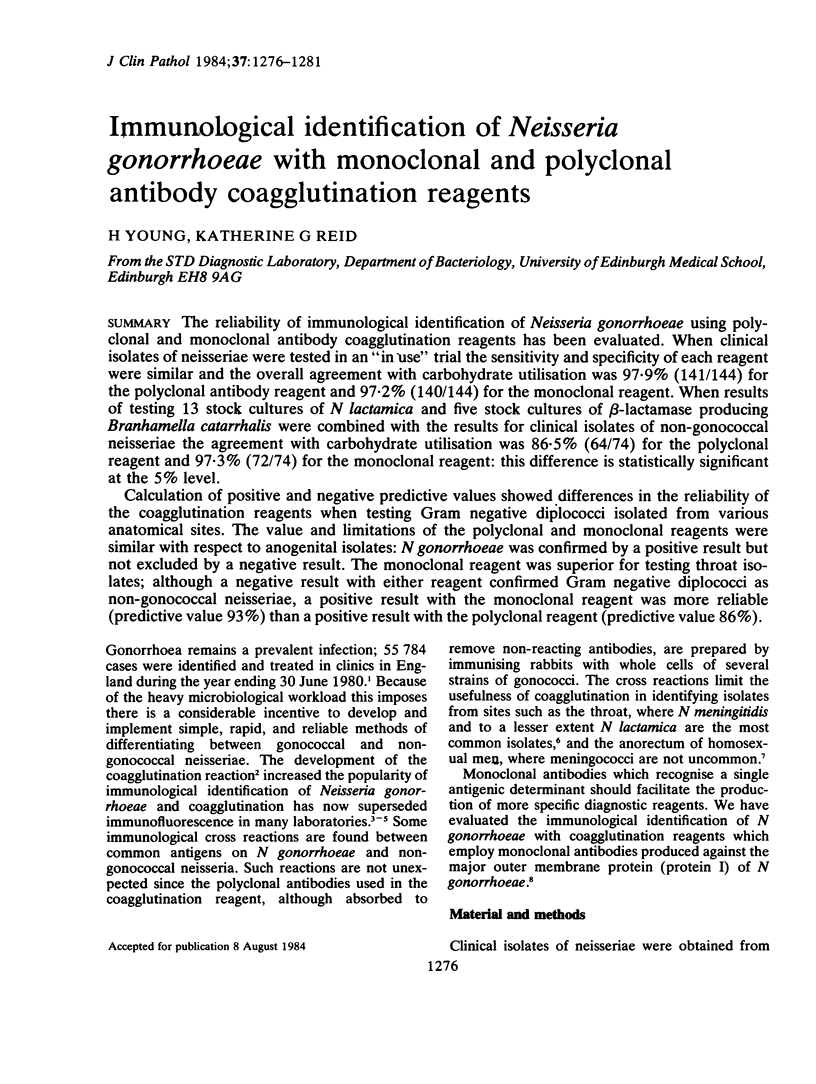
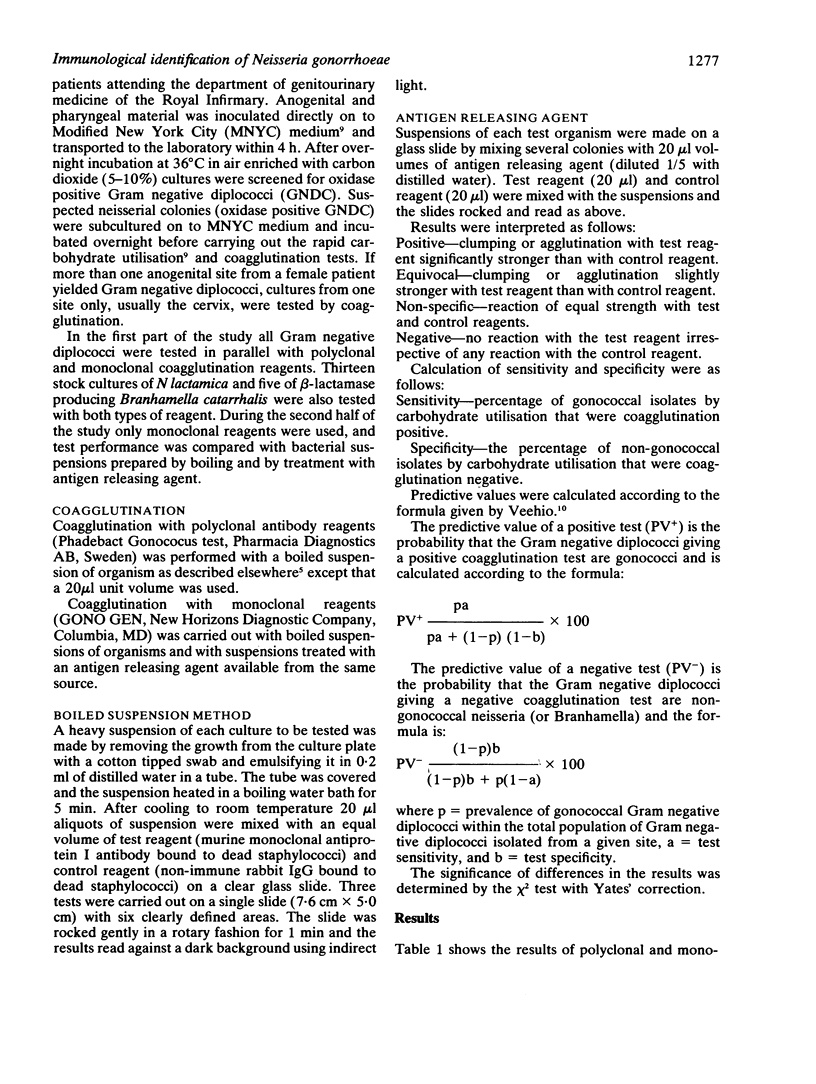
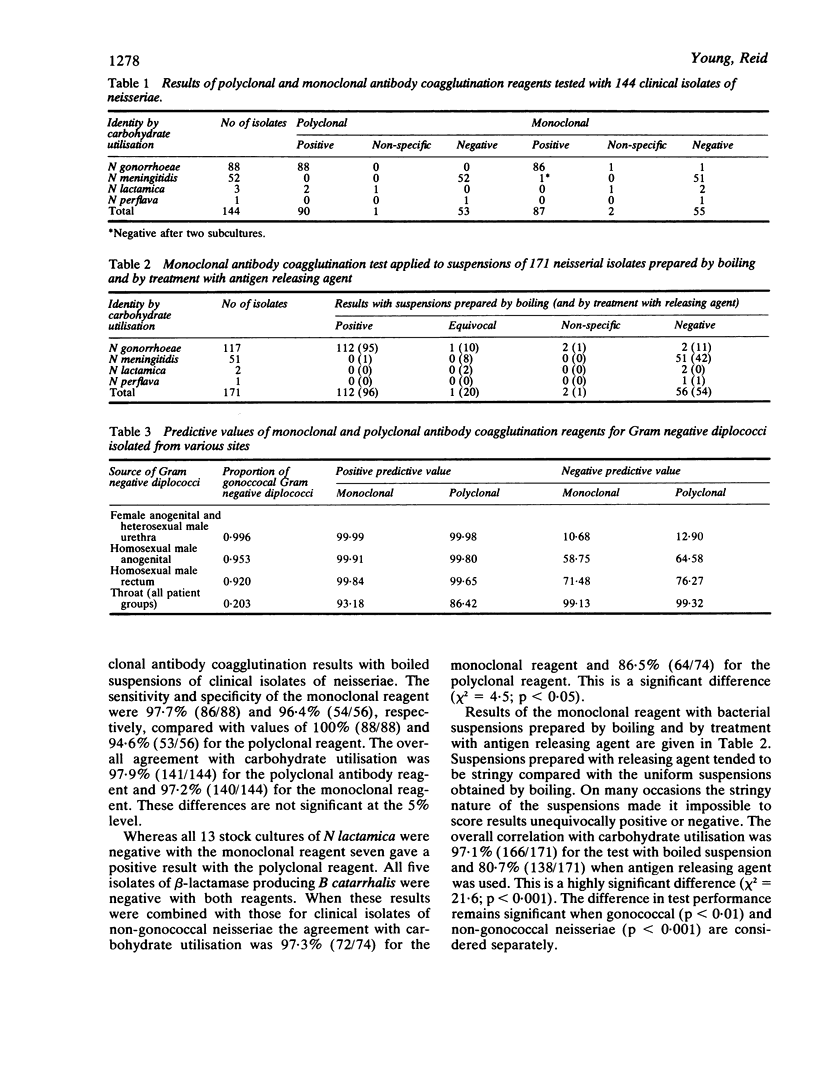
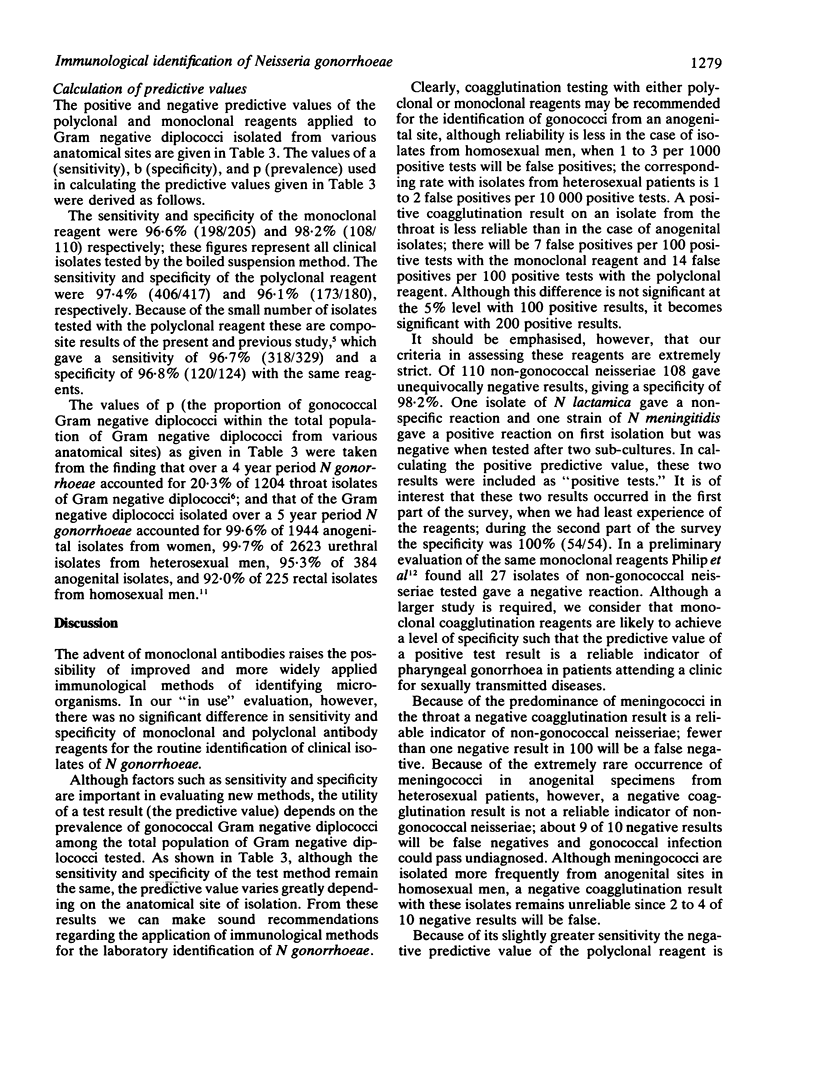
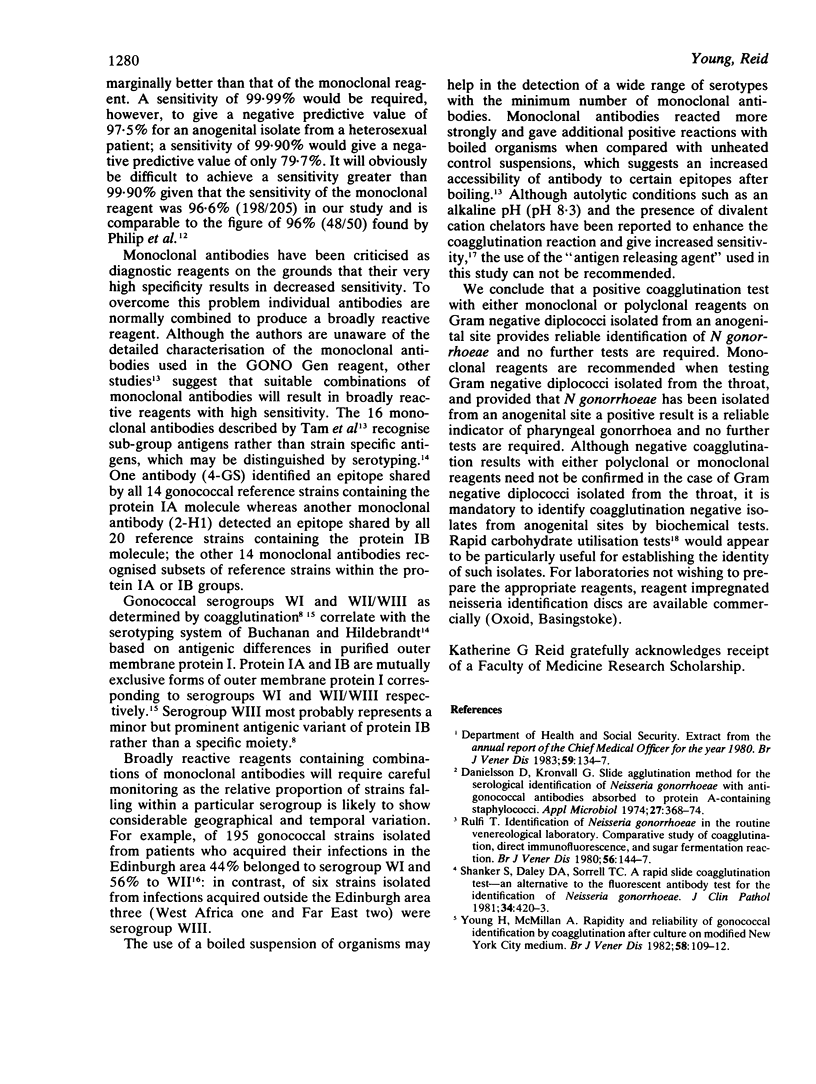
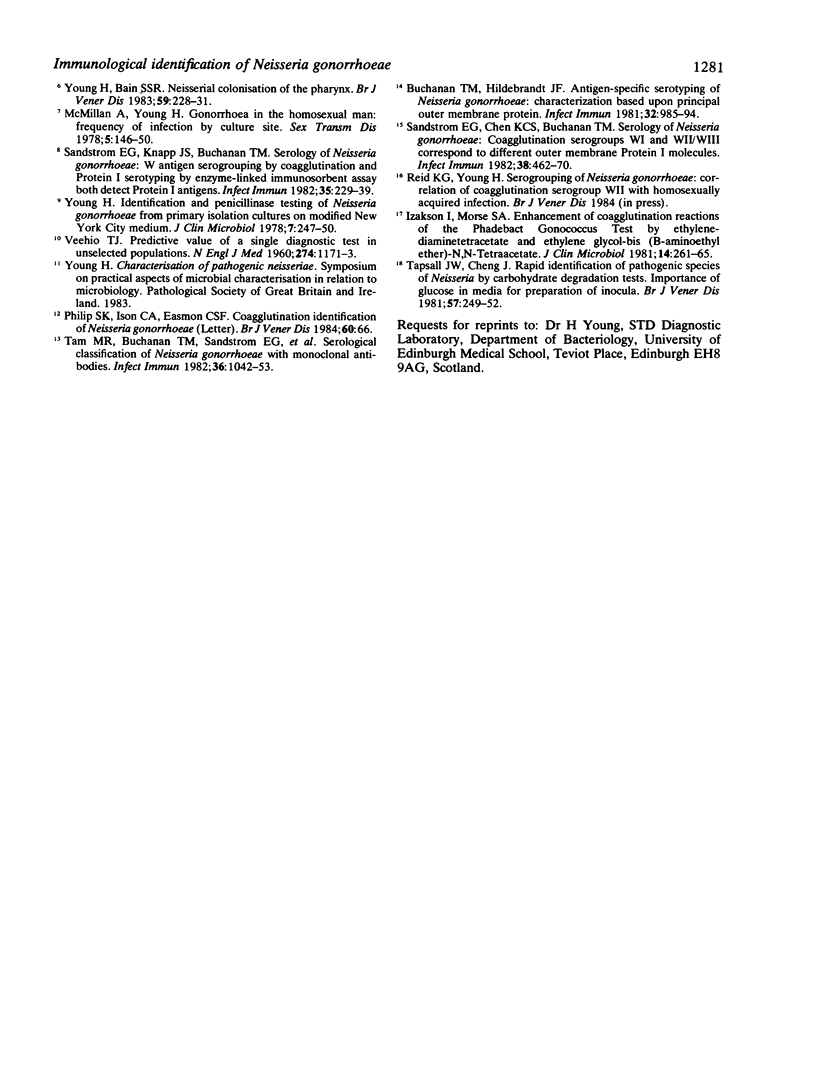
Selected References
These references are in PubMed. This may not be the complete list of references from this article.
- Buchanan T. M., Hildebrandt J. F. Antigen-specific serotyping of Neisseria gonorrhoeae: characterization based upon principal outer membrane protein. Infect Immun. 1981 Jun;32(3):985–994. doi: 10.1128/iai.32.3.985-994.1981. [DOI] [PMC free article] [PubMed] [Google Scholar]
- Danielsson D., Kronvall G. Slide agglutination method for the serological identification of Neisseria gonorrhoeae with anti-gonococcal antibodies adsorbed to protein A-containing staphylococci. Appl Microbiol. 1974 Feb;27(2):368–374. doi: 10.1128/am.27.2.368-374.1974. [DOI] [PMC free article] [PubMed] [Google Scholar]
- Izakson I., Morse S. A. Enhancement of coagglutination reactions of the Phadebact gonococcus test by ethylenediaminetetraacetate and ethylene glycol-bis(beta-aminoethyl ether)-N,N-tetraacetate. J Clin Microbiol. 1981 Sep;14(3):261–265. doi: 10.1128/jcm.14.3.261-265.1981. [DOI] [PMC free article] [PubMed] [Google Scholar]
- McMillan A., Young H. Gonorrhea in the homosexual man: frequency of infection by culture site. Sex Transm Dis. 1978 Oct-Dec;5(4):146–150. doi: 10.1097/00007435-197810000-00005. [DOI] [PubMed] [Google Scholar]
- Philip S. K., Ison C. A., Easmon C. S. Coagglutination identification of Neisseria gonorrhoeae. Br J Vener Dis. 1984 Feb;60(1):66–66. doi: 10.1136/sti.60.1.66. [DOI] [PMC free article] [PubMed] [Google Scholar]
- Rufli T. Identification of Neisseria gonorrhoeae in the routine venerelogical laboratory: Comparative study of coagglutination, direct immunofluorescence, and sugar fermentation reaction. Br J Vener Dis. 1980 Jun;56(3):144–147. doi: 10.1136/sti.56.3.144. [DOI] [PMC free article] [PubMed] [Google Scholar]
- Sandstrom E. G., Chen K. C., Buchanan T. M. Serology of Neisseria gonorrhoeae: coagglutination serogroups WI and WII/III correspond to different outer membrane protein I molecules. Infect Immun. 1982 Nov;38(2):462–470. doi: 10.1128/iai.38.2.462-470.1982. [DOI] [PMC free article] [PubMed] [Google Scholar]
- Sandstrom E. G., Knapp J. S., Buchanan T. B. Serology of Neisseria gonorrhoeae: W-antigen serogrouping by coagglutination and protein I serotyping by enzyme-linked immunosorbent assay both detect protein I antigens. Infect Immun. 1982 Jan;35(1):229–239. doi: 10.1128/iai.35.1.229-239.1982. [DOI] [PMC free article] [PubMed] [Google Scholar]
- Shanker S., Daley D. A., Sorrell T. C. A rapid slid coagglutination test-an alternative to the fluorescent antibody test for the identification of Neisseria gonorrhoeae. J Clin Pathol. 1981 Apr;34(4):420–423. doi: 10.1136/jcp.34.4.420. [DOI] [PMC free article] [PubMed] [Google Scholar]
- Tam M. R., Buchanan T. M., Sandström E. G., Holmes K. K., Knapp J. S., Siadak A. W., Nowinski R. C. Serological classification of Neisseria gonorrhoeae with monoclonal antibodies. Infect Immun. 1982 Jun;36(3):1042–1053. doi: 10.1128/iai.36.3.1042-1053.1982. [DOI] [PMC free article] [PubMed] [Google Scholar]
- Tapsall J. W., Cheng J. K. Rapid identification of pathogenic species of Neisseria by carbohydrate degradation tests. Importance of glucose in media used for preparation of inocula. Br J Vener Dis. 1981 Aug;57(4):249–252. doi: 10.1136/sti.57.4.249. [DOI] [PMC free article] [PubMed] [Google Scholar]
- Vecchio T. J. Predictive value of a single diagnostic test in unselected populations. N Engl J Med. 1966 May 26;274(21):1171–1173. doi: 10.1056/NEJM196605262742104. [DOI] [PubMed] [Google Scholar]
- Young H., Bain S. S. Neisserial colonisation of the pharynx. Br J Vener Dis. 1983 Aug;59(4):228–231. doi: 10.1136/sti.59.4.228. [DOI] [PMC free article] [PubMed] [Google Scholar]
- Young H. Identification and penicillinase testing of Neisseria gonorrhoeae from primary isolation cultures on modified New York City medium. J Clin Microbiol. 1978 Mar;7(3):247–250. doi: 10.1128/jcm.7.3.247-250.1978. [DOI] [PMC free article] [PubMed] [Google Scholar]
- Young H., McMillan A. Rapidity and reliability of gonococcal identification by coagglutination after culture on modified New York City medium. Br J Vener Dis. 1982 Apr;58(2):109–112. doi: 10.1136/sti.58.2.109. [DOI] [PMC free article] [PubMed] [Google Scholar]


